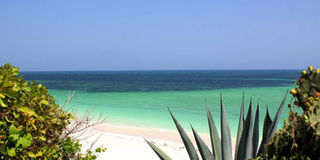TRAVEL: Lots to do in Watamu

View of Watamu marine Park from Kobe. PHOTO| JANE SPILSBURY
What you need to know:
Besides the turtles, there are lots of things to do in Watamu. “A tourist will be happy to stay at the hotel. A traveller will want to see everything,” remarks Guido Bertoni of Kobe Resort.
A veteran hotelier, he’s passionate about Watamu and everything it has to show. “A traveller will go to Arabuko-Sokoke Forest, Mida Creek, Gede Ruins and the ocean… it’s a culture.”
“Kobe is built with a lot of passion,” continues Bertoni. The use of grey is based on an ancient colour technique introduced by the Arabs called neru. It’s a natural die using spices.
Perched on the beach by the extraordinary Mida Creek facing the iconic Whale Rock where a few thousand Roseate terns have returned after an absence of five years, my eyes are fixated on the ocean.
I am at the Kobe Suite Resort, trying to scan the menu, set in recycled cement cover, to choose a meal for lunch.
But my eyes constantly wander to the ocean where the Roseate terns ride the waves using their energy to soar higher – white wings on the blue planet.
From June onwards, thousands will begin (hopefully) to nest on Whale Island while others will fly south to Kisite Island or north to Kiunga and Tenewe Islands around Lamu.
Where the terns fly in from to nest and where they fly once the chicks are ready to fledge is a mystery, according to the team of researchers from A Rocha Kenya that’s monitoring them and other sea life around Watamu.
Kobe is named after the turtles that swim the warm waters of the Indian Ocean, and where the females come to lay their eggs on the high point of the beach.
One in a thousand turtles will make it to adult-hood, their lives so fraught with danger. Little hatchlings that do make it past the beach spend time in the mangrove creeks of Mida Creek till they are older to tackle the big ocean.
Besides the turtles, there are lots of things to do in Watamu. “A tourist will be happy to stay at the hotel. A traveller will want to see everything,” remarks Guido Bertoni of Kobe Resort.
A veteran hotelier, he’s passionate about Watamu and everything it has to show. “A traveller will go to Arabuko-Sokoke Forest, Mida Creek, Gede Ruins and the ocean… it’s a culture.”
“Kobe is built with a lot of passion,” continues Bertoni. The use of grey is based on an ancient colour technique introduced by the Arabs called neru. It’s a natural die using spices.
It’s then mixed with white cement and neru (black powder). “All the building material is local – the coral block floors, the base of the beds in cement – it’s the aesthetics of matching the culture and location. Only the sliding doors and fittings are not local.”
It’s the beginning of the Kusi monsoon – the winds and the waves are beginning to turn rough. In centuries past, it was what brought the ancient mariners from Asia, Arabia and eventually the Europeans to the East African coast.
“Garoda is a Portuguese word,” Bertoni says. “It means the curves of a beautiful woman. After months at sea, when the sailors saw the stretch of this beautiful beach, it reminded them of that.”
It’s little wonder than that CNN voted Watamu’s beach as the second most beautiful in the world.




